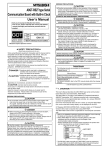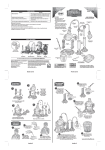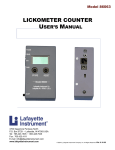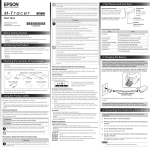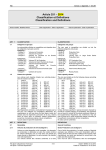Download Honda SOHC Charging System Troubleshooting
Transcript
Honda SOHC Charging System Troubleshooting Mike Nixon Here is a quick, neat, three-step method of checking your bike's charging system. However, to use it, you must understand the charging system. For example, note that there are two troubleshooting flow paths. One for when the output is low, and a different one for when it output is not low but the battery keeps going dead. So first, a few basics. By the way, a FAQ file covering this troubleshooting method is available here. Note: The CB650 SOHC model is excepted from this tutorial. It has the same charging system as the later DOHC fours, therefore go here to troubleshoot it. Charging System Basics The Four Parts The SOHC’s electromagnet charging system has just four major parts. The two primary parts are the rotor and the stator. The rotor is the rotating magnet and the stator is the stationary coil of wire. The third charging system part is the rectifier. As the alternator’s magnet spins, the induced electrical current changes direction in step with the magnetic poles. Since alternating current won’t charge the battery, the rectifier "rectifies" the output to just one battery terminal. The fourth charging system part is the regulator. The regulator prevents the alternator from producing too much at high rpm, because this would hurt the electrical components and the battery. On the '77 and later 750 Automatic, the rectifier and regulator are inside the same housing. The Two-Piece Rotor Honda’s earliest electromagnet charging system as used on the SOHC has an extra part, because it has a two-piece rotor. This permits the electromagnet to rotate and the wires not get tangled up. (Later versions as used on the DOHC engines used carbon brushes instead.) One half (the "field coil") has the wires, the other half (the "rotor") is magnetized by the first half and rotates. The Field Coil / Regulator Relationship The relationship between the field coil and the regulator is the key to understanding this system. The field coil’s electromagnetism is controlled by the regulator, which is wired between it and the battery. When the battery reaches 14.5 volts, the regulator interrupts the field coil’s power feed, which reduces its magnetism, and alternator output diminishes. Preparation for Troubleshooting Battery Load Test Charge the battery until a hydrometer shows that all cells are good, then load test the battery. You must start with a known good battery because the charging system is a two-way system, having both input and output. Consequently, battery faults dramatically affect charging system performance. Don’t skip this part. Charge Amps Test Because the charging system is a two-way street, charge absolutely must be checked in AMPS, not VOLTS. Set up your multimeter for its highest current scale, usually 10 amps. Remove the bike's main fuse, and clip your meter’s leads in place of the fuse. Check polarity by turning the keyswitch on. If an analog meter’s needle swings backward, that's good. If forward, reverse the connections. On a digital meter, you want a "–" (negative) sign. Start and rev the engine to 3,000 rpm. The result should be at least one-fourth the battery's amp/hour rating. In other words, 3 amps in the case of a 12 A/H battery. When The Output is Low Step One: Bypass the Regulator The first troubleshooting step is to bypass the regulator. However, before bypassing the regulator, make sure the field coil isn't shorted, because the bypass test might otherwise result in some rather dramatic electrical arcing. Set your test meter to Ohms X 1 and measure the field coil's resistance. Under 2 ohms is a short. Over 7 Ohms is an open. Both are bad. If you replace the field coil, skip ahead to Step Three to make sure the regulator isn’t bad also. Otherwise continue with the regulator bypass. How the bypass is performed depends on whether your system has the rectifier and regulator as separate parts or together in one part. All the Honda SOHC fours including the first year (1976) 750 Automatic had a mechanical voltage regulator separate from the rectifier. Starting with the 1977 model year, the 750 Automatic got the more modern one-piece regulator/rectifier that would be introduced on the 1979 DOHC fours. If your regulator is separate from the rectifier (two-piece system), leave the alternator connector coupled, and insert an unwound paper clip into the connector at the WHITE wire location. Run a jumper wire from the paper clip to the battery's POSITIVE terminal. This bypasses the regulator. If you have a '77 or '78 750 automatic that has the regulator and rectifier in the same housing (one-piece system), put the paper clip and jumper in the same place, but in this case connect the other end of the jumper wire to the battery's NEGATIVE terminal. In either case, with this temporary connection repeat the charge amps test, but this time, DO NOT EXCEED 2000 RPM (to keep from overloading the system during the test). If the alternator starts charging (and it wasn't before), the regulator is the problem. Service (if the regulator is mechanical) or replace (if the later electronic) the regulator and skip ahead to Step Three. If on the other hand the regulator bypass makes no difference in charge, perform the following doublechecks. First, dangle that same paper clip from a pencil an inch from the alternator, and turn the keyswitch on and off. If the paper clip doesn't "kiss" the alternator each time the keyswitch is turned on, there is no magnetism. You've already checked the field coil, so all that’s left is to examine the wiring leading into it, including the connectors. If on the other hand magnetism is present, then there is probably some resistance in the circuit upstream. Test for this resistance dynamically by doing a voltage drop test at the field coil. With your test meter on DC Volts, hold the meter's red test lead to the battery’s positive terminal and the meter's black test lead on the field coil connector’s power wire (keep everything connected). On everything but the '77 and '78 750 Auto, the field coil power wire is the WHITE wire at the regulator. On the Automatic having the later one-piece regulator/rectifier, the field coil power wire is the BLACK wire at the regulator. With the keyswitch on, the reading should be 1 volt or less. More than 1 volt points to a bad keyswitch or other switches or connectors, which you’ll need to check out. If necessary, repair or replace the indicated part and skip ahead to Step Three. If on the other hand these doublechecks pass, go on to Step Two. Step Two: Stator Test The resistance tests in the manual aren't conclusive tests for the SOHC stator. The stator is best tested in a special way, by stressing it. Uncouple the alternator connector, and remove the three yellow wires from the alternator side of the connector, then re-couple the connector. Clip a 2 ohm, 100 watt resistor ($10 at industrial electronics supply houses) across your meter's red and black test leads. This is needed to properly load the stator. Now start the engine. With the meter set to AC Volts and the leads held to any two of the yellow stator output wires, rev the engine to 5,000 rpm. Repeat two more times to check all three leads. The results must be the same for all three wires, and at least 25 volts. If less, the stator is bad. If on the other hand the reading is 25 volts or more, the rectifier is bad, because the stator’s output is stopping there. Replace the indicated part and go on to Step Three. Step Three: Retest Step Three is simply perform the charge amps test again. If you now get 3 amps or more, you’re home free. Congratulations! When the Output is Not Low Not all charging system problems are due to lack of charge. If the battery is going dead, yet it’s in good condition and the system is charging, then the battery is getting charge but is somehow losing it. That is, there is a leak in the system. We must find the leak. The same three-step method is used as before, with some variations. Step One: Test Breakeven Rpm This test, the breakeven test, pinpoints what kind of leak we have. Set up the multimeter for the charge amps test. The meter will read backward, that is, discharge, when the key is turned on. Start the engine and from idle, very slowly increase engine rpm. Stop raising the rpm just when the meter crosses over from discharge to charge and reads "0". This is the breakeven point. Note the rpm at which this happens. It should be under 2000 rpm. If over 2000 rpm, you have a dynamic leak, that is, a leak with the keyswitch turned on. On the other had, if the breakeven is under 2000 rpm, then the leak is a static one, one that occurs when the keyswitch is turned off. Remember which kind you have -- dynamic or static -- and go on to Step Two. Step Two: Find the Leak Find a dynamic leak by unplugging suspect electrical accessories one at a time, and don’t forget to check for a stuck brake light switch. Turn the bike off each time you unplug something, and restart it and retest breakeven to see if there is a difference. At some point the breakeven rpm will go down. The last component unplugged at that point is causing the dynamic leak. Repair or replace the component and go on to Step Three. Find a static leak by doing a key-off current check. Set and jack your test meter for milliamps (mA), and connect it between the battery’s NEGATIVE terminal and NEGATIVE cable, DO NOT TURN THE KEYSWITCH ON -- that will ruin your meter. Just read the meter as-is. Motorcycles with full-time electronics (radios, alarms, clocks, etc.) will indicate between 10 mA and 20 mA. Bikes without full-time electronics should indicate 0 mA. If the reading is high, something is leaking. If you can’t find it, it is probably the rectifier that is leaking current out of the battery. Double-check this by disconnecting the rectifier. If the drain stops, the rectifier is leaky. Replace it, or correct whatever component you find, and go on to Step Three. Step Three: Retest If your leak was dynamic, perform the breakeven rpm test again, as in Step One. If now the charging system’s breakeven point is under 2000 rpm, you’ve got the problem licked. Congratulations! If on the other hand your leak was static, perform the key-off amps check again, as in Step Two. If the key-off drain is 0 mA, or if you have a radio or alarm, under 20 mA, you have fixed it. Go for a ride to celebrate!





